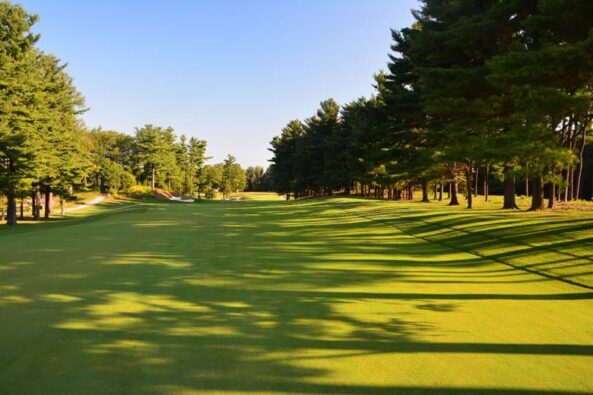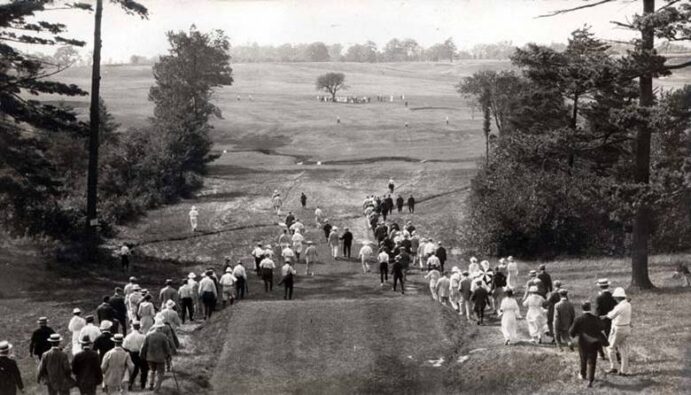
If you drop a pan into the river of history and sift out the sediment, you find nuggets of gold. One such gem is a catchphrase and concept first coined by Joseph Schumpeter, the renowned 1930s political economist.
His “creative destruction” mantra was a contradiction in terms, with real-life applications – especially for the golf industry and its“tree management” movement.
This is becoming de rigueur with course superintendents and preached as gospel at places of high learning like Guelph University, and its world-class turfgrass program.
Its scientific research is driving change at progressive clubs around the world. The goal is simple: protect healthy turf, the number one priority of course superintendents everywhere.
Taking a peek inside the most pressing issue of our time was the impetus behind the Golf Journalists Association of Canada (GJAC) and its sponsor RBC in holding a one-day, online seminar earlier this year called ‘Climate Change and Golf.’
It was moderated by Dr. Sara Stricker of the Turfgrass Institute, with panelists like Professor Eric Lyons (Guelph), Dr. Matt Pringle (U.S. Golf Association) and Keith Lyall, superintendent at Sun Peaks Resort in B.C.
The golf industry has a critical role to play in sequestering toxic carbon as our ongoing love affair with fossil fuels continues unabated. Both trees and turf trap this dreadful by-product and helps purify the air we breathe. A golf course, once viewed as a playpen for elites, is now a green oasis, a check against the creep of urban sprawl. Golf is a partner as cities work to hit carbon-cutting goals set out by the United Nations and the Intergovernmental Panel on Climate Change (IPCC).
Golf courses are laboratories, stated Lyons, and that’s doubly true as climate change disrupts our world, especially through fires and flooding. The destruction of the Kaninaskas club in Alberta by spring run-off, and the horrific forest fires that edged close to clubs like Sun Peaks, are signs that the danger to the golf industry is raw and real and ever-present, says Lyall.
Canada is tree rich (318 billion at last count, which works out to 8,953 per person) and thousands of these hardwood/softwood beauties frame many of the 2400+ portfolio of courses that fit under the “parkland” descriptor.
Many have now installed aggressive “tree management” programs, which will dramatically change their look and feel.
Nowhere is this truer than at iconic Hamilton Golf and Country Club (HGCC), host of the 2019 RBC Canadian Open, which returns there in 2024.
The 27-hole club is wrapping up an $11 million re-design, which includes a thinning out of its bountiful tree canopy. Call this a ‘Back to the Future’ initiative which slips it back to its original design, set out in 1914 by famed English architect Harry Colt.
Colt left Canada before completing his masterpiece, but left instructions, drawings, and its original layout in the club archives. This was dusted off for a re-build that began immediately after Rory McIlroy holed out to win in 2019.
A return to norm means trimming back to find the long-hidden vistas covered over by the expansion of its tree canopy. The culling of trees began in the 1990s under long-time superintendent Rodd Trainor, who was also a consultant in the re-design. He joined outside consultant, Eric Ebert, an England-based Colt disciple, and Trainor’s HGCC heir, Jordan Kitchen.
The bid to recapture the true essence of iconic clubs has bled across the US-Canada border, and began when iconic venues like Oakmont (Pennsylvania) and Shinnecock Hills (New York state), part of the U.S. Open rota, began their re-dos.
Everything changed in 2007. Oakmont (ironically named after its majestic tree canopy) bared its chest to the golf world, returning to its treeless roots. Over 7,500 trees were eliminated, then 7,500 more. A few lonely oaks remained, and the look was shocking. The denuding forced the golf industry to look in the mirror.
Some were horrified, others inspired, and the broad vistas, and the vastly improved turf conditions, has spurred a movement best described as “less is more.” Less trees means more playability. No wonder Shinnecock followed suit, with the same results.
HGCC’s changes are subtler, less Oakmontish. Maybe it’s a Canadian thing. After all, our flag is the maple leaf. But times have changed, and so have perceptions. HGCC isn’t the only club going backwards to move forwards. It’s interesting to note that another Colt gem, Toronto Golf Club, also a founding member of what is now called Golf Canada, has gone au naturel, allowing non-golf areas to expand, cutting the time and money needed for upkeep.
Trimming trees, opening up sweeping new vistas and showing faith in the original design, might alarm tree huggers and eco-warriors everywhere, but HGCC’s changes are more judicious than Oakmont. Still, they make holes more playable, create cleaner shot lines, and most importantly, produces healthier grasses.
Golf course grass is in a life-and-death battle for sunshine, air flow and water, something trees also need, and greedily use up. This battle increases the need and use of fungicides and harsh chemicals to counter the harmful effects, especially on greens . This ups the cost of maintenance, but also puts in peril ecological stewardship.
Saplings grow into mature trees, and this creep-out begins to overhang fairways, tee boxes and greens. The aggressive tree-planting programs in the middle of the last century often introduced non-native trees to clubs in a willy-nilly fashion. This cast shade over delicate areas, and the battle to pull back began in earnest early in this millennium.
Augusta National has long been the gold standard for parkland design. It is prettified and greener than the first day of creation, and much of that look induced a fair share of sentimental twaddle about how this is good for the game, and course design. The truth is more cryptic. Much of the course beauty was artificially or chemically enhanced, and after that special week in April, the club was left fallow to recover.
The Augusta-look has dominated our design ethos, but a minimalist movement (“less is more”) is on the upswing: less water, less pesticides, less chemicals and even less tree cover. It’s healthier and more sustainable, in both the short, and long-term.
The barren links of St. Andrews was the model Colt admired when he drew up his design for HGCC. The current re-design reflects his original intention.
Ebert is thrilled with the results. He thinks golf fans, tour players, and the HGCC members will see a dramatically different course in 2024 – better shot values, and less of a “bowling alley” look where holes are 18 separate lanes. HGCC has definitely turned a new leaf, as part of its 2030 masterplan. Said Ebert: “There simply were far, far too many trees.”
Alan Carter, the recently hired COO, is a golf industry veteran who has overseen clubs across Canada. He says HGCC is a sacred trust, and the changes will only enhance “its look and feel” as the world comes knocking at its door in 2024. “Everyone will love the changes,” he told Pro Shop.

Hamilton G&CC 16 east . . . shows some of the clearing that was done under the trees on right
The massive tree-planting programs in the mid-20th century reached such a critical mass that a tree-versus-turf war over water, air, and sun, had to be fought.
Taking away some of the tree overgrowth has unlocked a buried treasure, like the original Colt design at HGCC. The work to remake the model wasn’t easy because most of the work was done online, via Zoom meetings during the pandemic. Ebert (England) and Kitchen/Trainor (Hamilton) worked in tandem to implement Colt’s game plan to the nth degree.

Hamilton G&CC: The gallery walks from the No. 11 tee during the 1919 Canadian Open at Hamilton Golf and Country Club. J. Douglas Edgar won the event by 16 strokes, which remains a PGA Tour record for victory margin.
Trees need to be managed because they are subject to damage from disease, insect infestations, fires, hurricane-force winds, rogue ice storms, even violent spring run-off. Climate change is a harsh mistress – dangerous and costly.
Courses now have in-house and outside arborists to keep their tree canopy healthy and in trim, and chainsaws have become the 15th club in the bag of innovative superintendents.
The Augusta-like look is a fanciful sign of spring for many winter-weary Canadians. But for golf clubs, it’s becoming more passé by the day.
Institutions like Guelph are literally helping change golf course topography. GJAC’s hour-long seminar touched on a multitude of issues that superintendents face in the coming years, with turf and tree management topping the agenda.
Sure, there has been plenty of protests from tree-huggers and eco-warriors, especially in the neighbours surrounding golf clubs. The sound of chainsaws is firing up their enmity, and producing some inflammatory headlines and news stories. But even the Audubon Society is all-in on course changes, and its ‘Sanctuary Program for Golf Courses’ is another sign that designers like Colt were ahead by a century when it came to knowing what was good for the game.
Maybe Oakmont’s tree management program was too harsh. Maybe HGCC’s Goldilocks-like program has found just the right temperature for our times.
It’s also true that at one time, when a tree fell in the forest, no one would hear or care. Now everyone hears and cares, especially about the roar of chainsaws, and the felling of trees. Do too many of them misinterpret this as the sound of destruction?
Schumpeter showed us that destruction also has its creative side.











